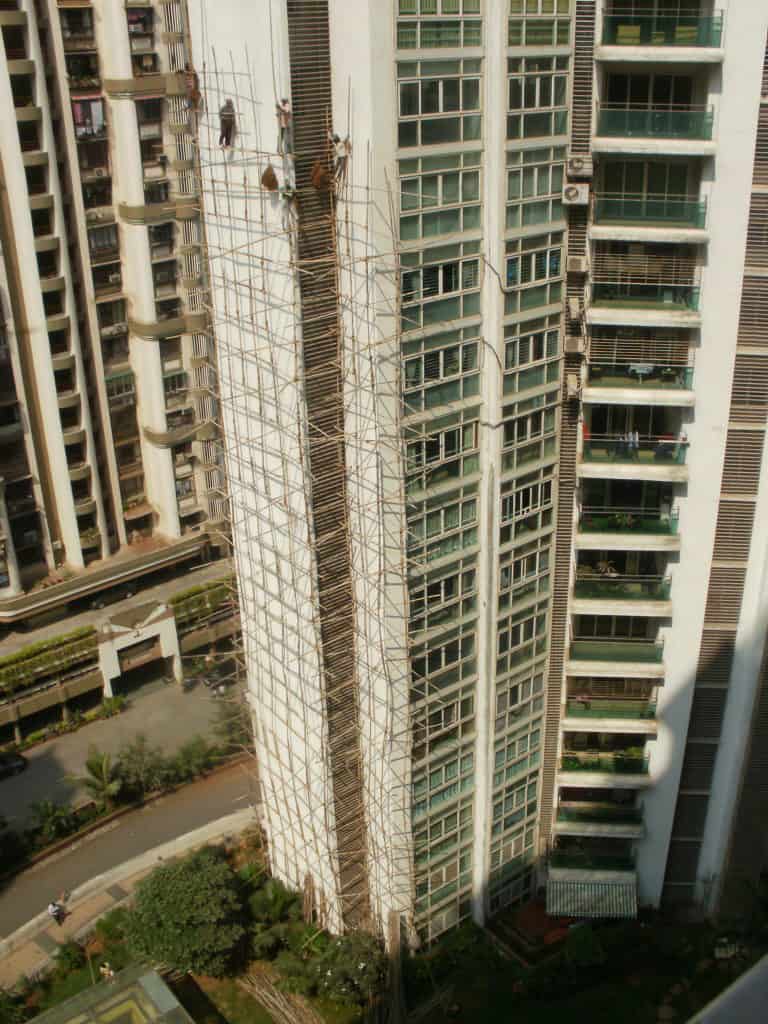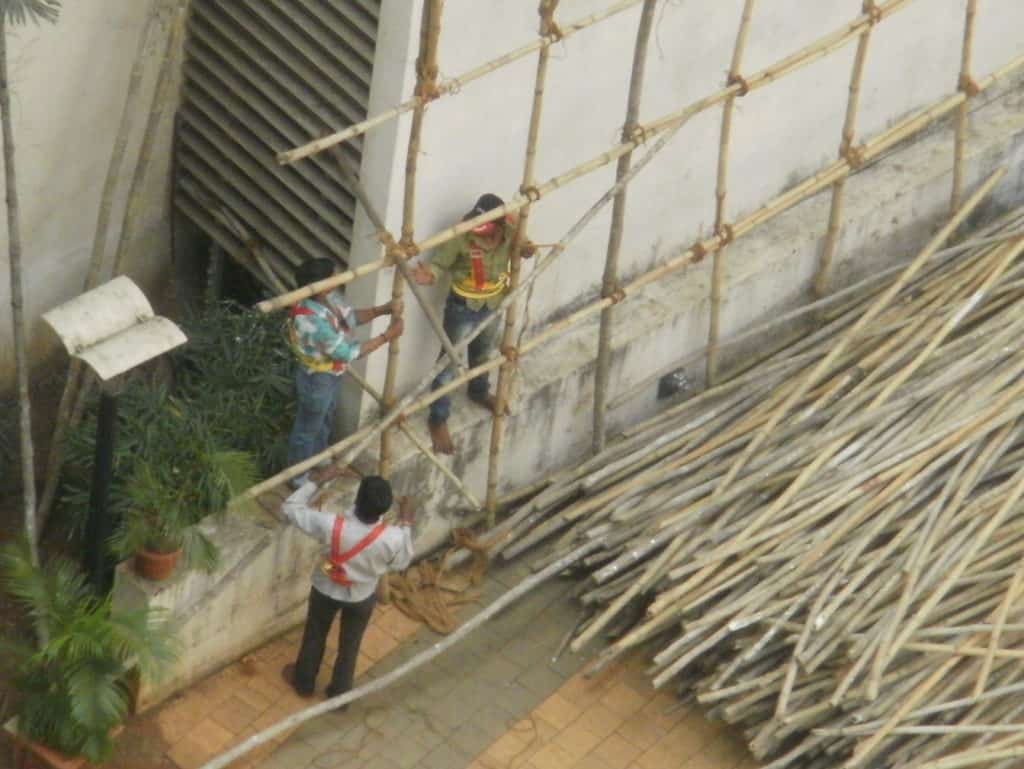In August, two workers died when a suspended scaffolding they were standing on fell. They were at an under construction building in Vikhroli.
Accidental falls from high rise buildings can happen not just during construction, but also during renovation and maintenance.
When people work along the walls of buildings (like Spiderman) at heights of some 200 feet above the ground (for cleaning, painting, water proofing, netting or any other reason), it is expected that there would be something tied to them (such as a rope) and/ or something put below them (such as a net) that will save them if they fall.
So when you see ten men deftly balancing on casuarina/bamboo poles that they are also twining into a neat upward growing scaffolding, with only their skill and experience separating them from a smashing end, several storeys down, your heart is in your mouth!

The first thoughts that come to mind are – What will happen if they fall? How can the contractor be so irresponsible? Why has the employer not ensured that the contractor provides proper working equipment? Don’t their lives have any value?… and the like.
In my apartment block in Mumbai, I caught work happening on 12-13 floors. They had another 8-9 floors to go and I was trying to get them to go no further until they were properly equipped.
Harnessing safety
I first followed the accepted practice for complaints and grievances in the apartment block – I wrote to the society office, concerned committee members and met the society manager, requesting them to take action.
After a few hours I saw that the scaffolding had progressed further up. At times the poles would dangerously sway high above, till they were tied in position. I saw workers balance themselves precariously for a drink of water high in the sky.
I decided that I would need to do something on my own. I got the contact information of the contractor who was carrying out the job and I called him. He told me that workers who do scaffolding work do not generally wear harnesses because it hinders their movement up and down the scaffolding. As if to pacify me, he said that the people who will do the water proofing work (which is the reason why the scaffolding was being put) would be equipped with harnesses. And what if one of these scaffolding men fell? It didn’t take long for him to admit that they should have been wearing harnesses and he said he would instruct them to do so immediately.
To follow this up, I quickly went to the work site to talk to the workers. There I saw one harness carelessly lying with the stacked up poles. I asked the two workers who were nearest the ground, why they weren’t wearing the harnesses. And they told me that it makes their work take longer because they need to keep un-fastening and fastening the harness clips as they move up. And if you fall? “We won’t fall”, he said. Hopefully not. I told them that I’d talked to their big boss, and he had agreed that they should wear the harnesses from the following day as it was already close to the end of the day’s work.
Just as a bike rider wears a helmet even after riding for 20 years, I told them it was important for them to be safe in case of an accident. I tried to explain to them that they shouldn’t be relying on their skill and luck to get them home safe to their families at the end of the day. Don’t they value their lives? Forget the extra time the harness takes, if they fall it will be the end of time!

Then I heard one of the men telling the other that they should take out the harnesses (from the store room) the next day. They talked in Telugu so I talked back to them in Telugu telling them “tomorrow, no harness, no work”. They were delighted and asked where I was from. When I said Bangalore, one of them started talking in Kannada saying he was from Gulbarga. Before leaving, I reminded them that from tomorrow they were going to wear the harnesses, not to satisfy me or anyone else in the building, but for themselves and their families.
As receivers of various services, each one of us can do our bit in ensuring that our service providers and their workers make no compromises when it comes to their safety. And go a bit further in making them realise that their lives are precious.
Valuing life
A small contractor with whom I was discussing this safety issue said that his workers have been given helmets, harness, safety shoes, etc., but he found that they were wearing them only when they saw him enter the site. Most of the time they don’t wear the safety gear. This, despite the fact that he had told them that he would rather kick them out and keep the site safe rather than risk someone falling. He felt that value for human life is very minuscule, unfortunately even in the workers’ eyes.
The next day, I followed up. I met the young men (most of them look like they’re in their late teens or early twenties) and it was so good to see all of them wearing harnesses. The whole lot was Kannada speaking so I could interact quite easily with them. I told them how happy I was to see them wear the harnesses. Also mentioned that wearing it on one’s person was not enough, but each needed to tie/ clip it to ensure that it holds in case of a slip or a fall.
They introduced me to their “Maistry” (supervisor), a slight man in his late years who said he was happy that someone thought about “safety” and got the boys to wear the harnesses.

As they proceeded to assemble another scaffolding, I hoped the workers would remember to keep themselves safe as they moved up. After all, as one of the boys said, “it is for our safety. Now we know.”
This article was earlier published on the writer’s blog here and has been published with permission, after small edits.